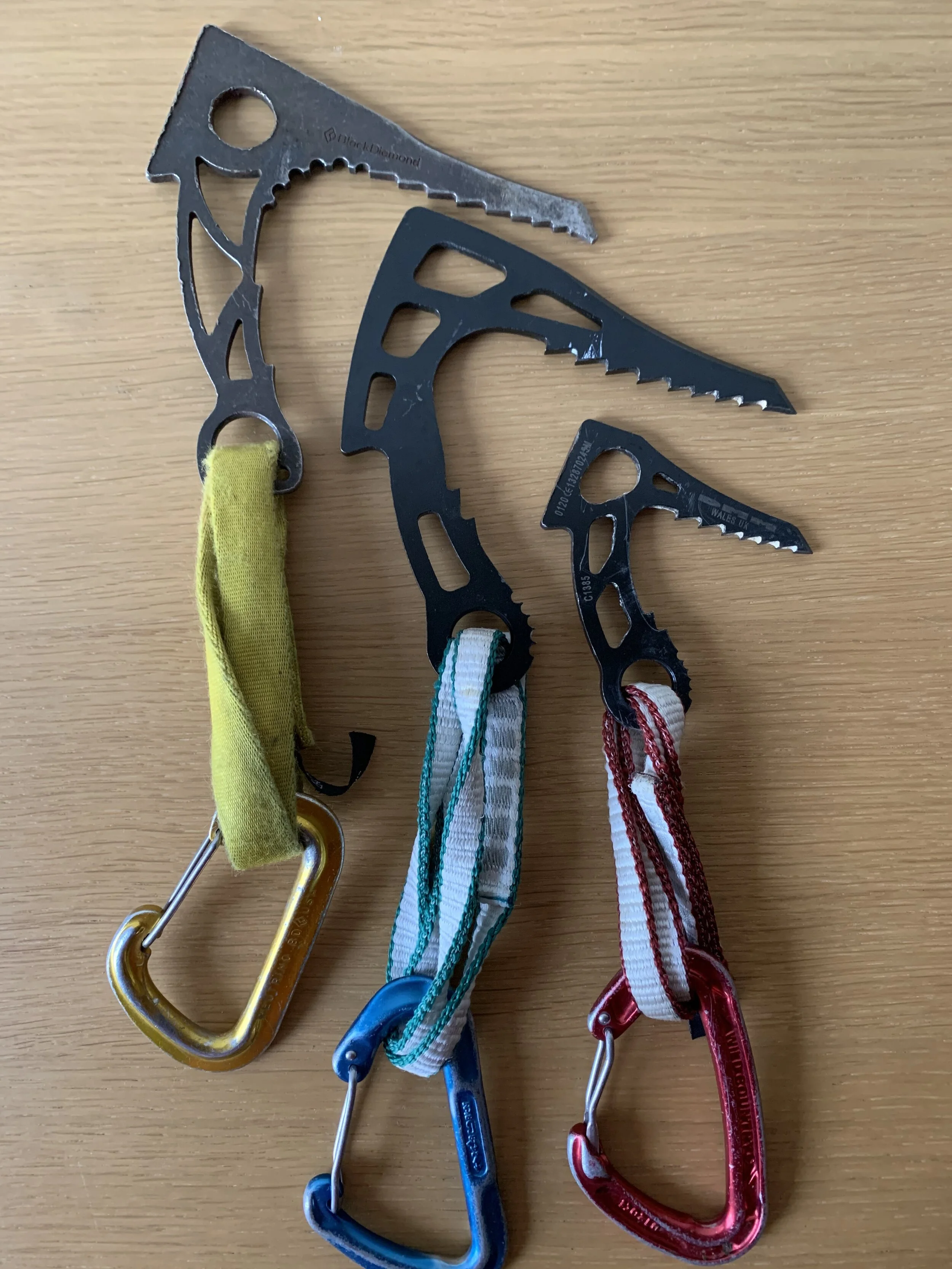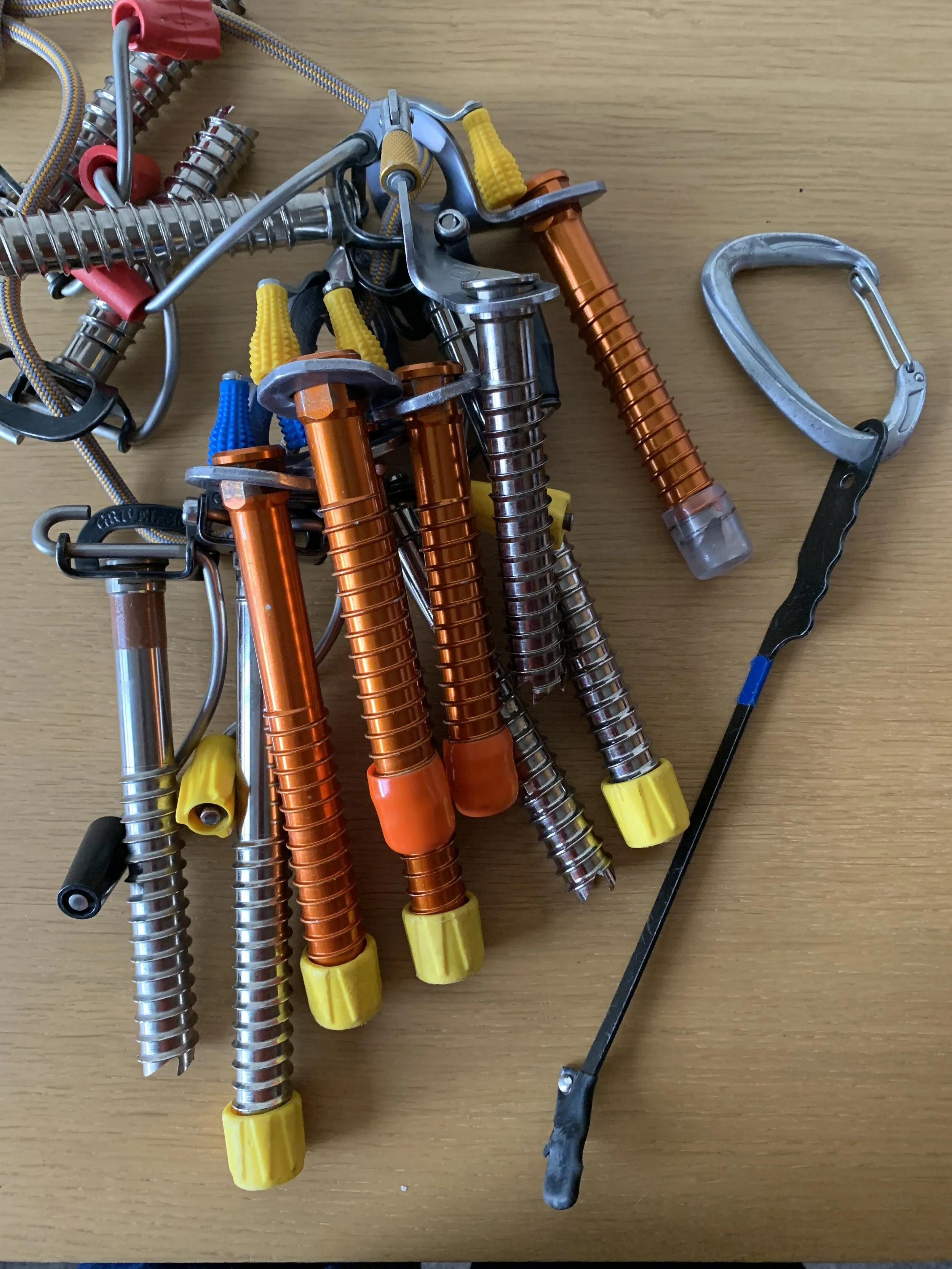Protection for Winter Climbs
Protection can be hard to find on winter routes. Snow and ice clog up cracks which would normally take summer rock gear so some additional winter specific pieces of pro can be vital to get you safely up a route. It's worth practicing placing gear in a safe environment before trying anything out for real. The Scottish winter environment is particularly unforgiving so if there is doubt about your skills seek get professional advice and instruction!
Bulldogs
Left to right: a Spectre, Bulldog and Terrier
Also called Spectres or Terriers (in the smaller sizes), these hook shaped pieces of metal offer a range of options for placement. Hammered into thin cracks or into well frozen turf they can offer good points of protection. I usually carry two: a Bulldog and Terrier when climbing hard mixed or turfy routes, and often take a single Bulldog when climbing adventurous ice routes as an additional piece for ice which wont take an ice screw.
They are placed by hammering in from the top of the hook and removed by tapping upwards on the small lip at the top of the shaft.
Pegs
Left to right: A long Knifeblade, short Knifeblade and two Angle pegs.
Also called Pitons or Pins, These short metal blades of varying thickness can be especially useful in thin icy cracks, where the action of hammering them in clears the ice and gives good contact with the rock.
On well established mixed routes such as those found in Corrie Sneachta pegs are usually unnecessary as the cracks are pretty clean from all the traffic they receive.
On more esoteric routes, especially on the West Coast of Scotland, carrying a set of pegs can pay dividends in providing some good protection, especially at belays where a good ledge can be used to stand and hammer.
I generally carry a U shaped Angle peg plus one short and one long Knifeblade if I expect icy cracks on a mixed route or am climbing something adventurous. My pegs have small loops of cord for easy racking. This isn’t full strength and is not for clipping into, but just to allow the pegs to hang unobtrusively from the racking crab.
Warthogs
Three Warthogs
Resembling an old school ice screw, a Warthog provides the best of the limited protection available from frozen turf. They are placed by hammering in, and removed by twisting out.
On really turfy climbs such as those around the Bridge of Orchy or Southern Highlands, I may well carry up to three Warthogs. They can also be hammered into cracks, but don't be surprised if your second doesn't manage to get them out afterwards!
Ice Screws
A selection of ice screws from Petzl, Grivel and Black Diamond plus a Petzl Abalakov threader.
A vital part of any winter climbers rack is a good selection of ice screws. For pure ice climbs you will need at least two screws per belay, plus another 6-10 depending on the length of the pitches, so 10-14 screws in total.
I have a selection of different sizes to choose from. Often in Scotland the ice isn’t particularly thick so most of my screws are shorter sizes. It's worth taking one long 22cm screw for making Abalakov threads, plus a threader tool, knife, and cord for making an Abalakov to abseil from.
I have some super light alloy Petzl screws as well as standard steel. I have found the orange super light screws can be hard to get into wet and sticky ice so having some steel ones to hand can save faffing. The weight saving of using super lights is considerable so I usually get my climbing partner to carry the steel ones on the walk in…
It's important to get some plastic screw clips for your harness, like the Petzl Carritools, to rack your screws on. I remember trying to climb ice without them and getting your screws off a snapgate without dropping anything is really difficult!
Summer Rock Climbing Gear
In addition to any winter specific gear, I also will carry most of my standard summer rack. Check out my article on summer gear for some more in depth opinions on building a trad rack.
Hexes
Hexes are the king of protection in the winter. Nothing will make you feel better than hammering a huge hex into a crack! The DMM wired hexes are my favourite for both summer and winter use as the wire makes them a little easier to place than the dyneema sling versions.
Wires
Two extra large Wild Country nuts
After hexes, a good wire is the next best option in the winter. I generally carry two sets spread across three crabs. The two XL Wild Country nuts pictured above also make for a good winter addition to your summer nut selection.
The wire cables on nuts are prone to damage when they’re hammed into a crack, so be sure to tap gently if you are going to use your axe to seat or remove a wire, and remember to check for damage regularly. I’m very cautious of any frayed wires and will retire any with cable damage immediately.
Cams
In the winter, cams can range from bombproof in dry Cairngorm granite cracks, to completely useless if the cracks are even slightly icy. Generally for a mixed route I will carry a complete set of size 0.3 to 3 Black Diamond Camalots. These are my preference for winter climbing as the thumb loop makes them easy to manipulate with gloves on.
It always pays to do your research on winter routes: several classics require a really big friend to protect them (eg. carrying a BD #5 for Bulgy) so it's worth reading the UKC comments to see if anything large is required!
Quickdraws
Generally I will take 12-14 quickdraws, mostly 18-25cm with at least four as 60cm sling draws. Whilst it's tempting to carry draws with tiny superlight snapgates, these are hard to handle with gloves on and I find a slightly large crab easier to clip quickly. DMM Phantoms or Alphas are my go-to winter quickdraws.
Slings
A good selection of 120cm slings are useful in the winter for extending placements and slinging chockstones. I will generally carry four 120cm slings and one 240cm.
Personal Gear
Always attatched to my harness will be a belay plate, three spare screwgates and an old screwgate I don't mind leaving behind if we have to retreat from a route. On the old screwgate I will carry some absail tat, a couple of prussicks, a knife and a whistle. I don't carry a nut tool in the winter, your ice axe will do a much better job!
Want To See More?
Head over to Instagram and follow me @lucajcelano for more tips and tricks.
Not Sure What You're Doing?
Feel like you need some help with your climbing? Why not book onto a Winter Skills or Self Rescue course and get some professional input on your anchor building, learn some new skills and take your climbing ropework to the next level.





